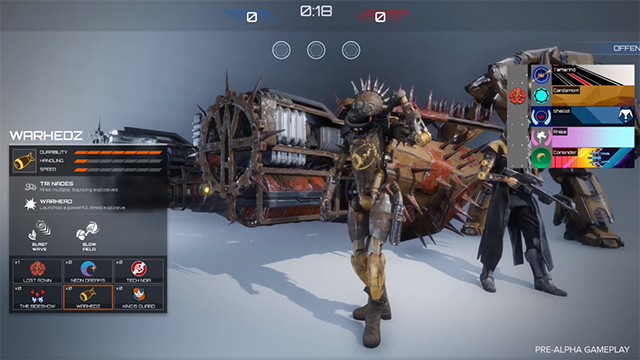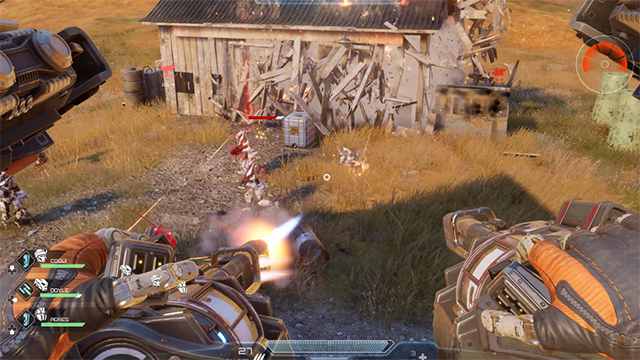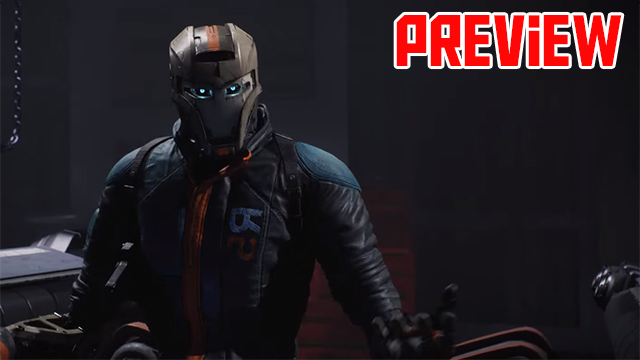Multiplayer is a ruthless arena where people tend to stick to their small familiar pool of online games. And newcomers need to either stick out or best any game in a player’s cycle; both of which are tough propositions. It’s like a battle royale full of a lot of battle royales. While it remains to be seen if Disintegration’s quality will overtake anything in your rotation when it releases in 2020, it does have a hook. And judging by its gameplay it has a chance to have that quality, too.
Part of this stems from the DNA behind it. V1 Interactive is a new studio built from budding talent as well as ex-Bungie and ex-Zipper Interactive staff. Marcus Lehto, V1’s president and the game’s creative director, was creative art director at Bungie while Mike Gutmann, V1’s vice president as well as the title’s CTO, held “number of studio leadership positions at Zipper Interactive.” Not only were (and are, in Halo’s case) those well-respected series, but they were respected for different reasons: Halo for its relatively faster gunplay and Socom for its tactics.
Disintegration melds both of those disparate playstyles. It may appear to be a first-person shooter but it’s also a tactics game as you hover around the arena in a hovering grav-cycle while issuing simple commands to your chosen squad. This means you can shoot others while also directing around a small team of units with simple, context-sensitive directives. Attack that enemy. Take that point. Grab that bomb.
The combination is a game that is quicker than a strategy game while also have the tactile involvement a first-person shooter. It’s got a lot going on to since you have different abilities, squad with varying stats, and firearms that differ heavily between the title’s array of unique classes. Managing everything takes thought and is where the game derives it comparatively methodical (but not slow) tempo. Such a tempo is refreshing as everything still feels snappy and responsive like a good competitive game, but with a weight that reinforces that you think first, which is further reinforced by the grav-cycles being floatier than on-foot traversal. Lehto calls this feel the “golden nugget” and explained the process the team took to strike that gold.
“We weren’t chasing the tail of all the latest shooters or anything like that,” he admitted. “We were looking for something unique. So we took that element of the first-person shooter, putting you in the seat of the grav-cycle, and we wanted to slow the pace down a little bit because [the units] are a key component to you. So you’re tactically using them in combat. The player has the ability position to their crew tactically and even flank and do cool maneuvers in the grav-cycle. So you as an entity have a lot of freedom to do neat things together that you would never do in a traditional first-person shooter.”
Disintegration Preview | Squad up

Some of that freedom stems from being able to float at differing heights while some of it comes from the classes. While the game will have nine classes when it ships, only six were shown and your abilities change as well as your squads that run below you on the ground. The Warhedz class is for the tanks out there as they can soak up more damage and shoot a triple grenade burst as well as a sticky bomb nuke that can one-shot the other players. It’s hard to land but incredibly satisfying. The Lost Ronin are a bit faster and can throw concussive grenades while you can fire heat-seeking rockets. There seem to be enough classes for every kind of playstyle so hopefully it’ll be balanced enough to support healthy team play as it did seem quite focused on communication and filling voids. While these units seem integral to the game now and serve as part of its appeal, they actually had a different origin that echoes the first Halo in more ways than one.
“The whole game actually started as a real-time strategy game,” said Lehto. “We were initially micromanaging the little crews on the ground and they worked very similar to the ones we have right now. But when we decided we were developing something that was going to be up against a steep competition of lots of other games being built by gigantic studios out there, we felt we as a small studio needed to leverage our creativity and do something different that isn’t being done out there. And we took a risk and turned that camera in the sky into a vehicle that made you an active participant in combat.”
Although Disintegration has promising fundamentals with some depth, many multiplayer games live and die how they are supported after release. The game will receive post-launch content without loot boxes but the exact roadmap is unclear. But that doesn’t mean there isn’t a plan. Lehto spoke about how fluid V1’s development schedule is and how it is dependent on what players are vocal about and want to see.
“So what we want to do, and this is one of the great things about the game because it is a smaller form factor, is listen to what is connecting with the fanbase,” he said. “And we can shift and pivot a little bit here and there. So it really allows us the flexibility to focus on that kind of stuff as well as what kind of crews people are attaching to and what voids exist. That’s our goal there: to not let it get stale.”
Disintegration Preview | Not just for the competitive crowd

Even though everything so far about the game has been about the multiplayer, it’s also going to launch with a single-player campaign. While still shrouded in secrecy, it will allow players to explore the battlefields more intensely to hunt for salvage to upgrade their crews. Given how it wasn’t shown, it remains to be seen how this will pan out. But, again, there is single-player pedigree behind it and Lehto is adamant that his team’s drive will help satisfy the hunger for solo shooters.
“There is a huge void where a lot of people want a single-player campaign,” said Lehto. “We’re filling that void because we love it. We love story. And me, personally, any good game with a deep lore and a deep story fiction behind it creates and a spark of imagination. And it really helps drive relevance and foundation to not only what we are doing with the single-player but multiplayer as well and beyond that.”
Even though it will have a campaign, it’ll probably sink or swim based on its competitive merits. Premium multiplayer experiences in new franchises can be a difficult sell but Disintegration looks to be banking off of its blend of genres to overcome those humps and appeal to players hunting for something new. It’s got potential in its smooth mechanics and varied classes and its pacing isn’t quite similar to any one shooter on the vast marketplace. Time will tell if those mechanics truly do work in a live setting where it will all be put it through its paces as well as if players are eager to play something with a more tactical pace in the shoes of a first-person shooter. But it looks to have enough pieces it needs to stick out and players are usually starving for new experiences. Hopefully that promising combo doesn’t disintegrate before the game releases or shortly after.











